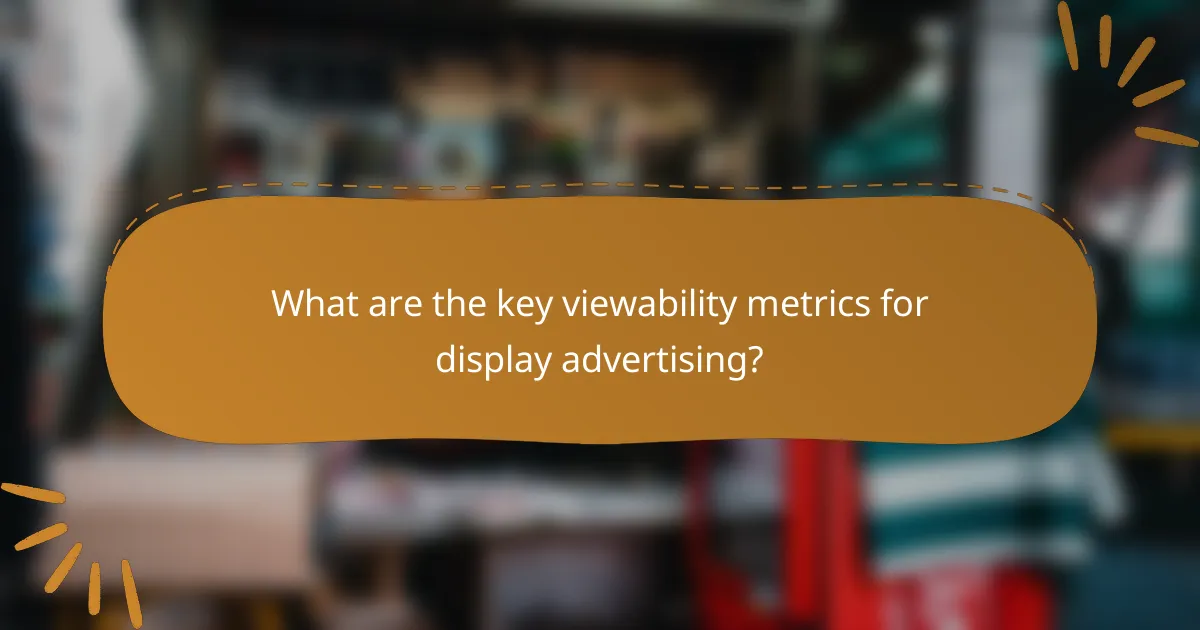Viewability metrics are essential for evaluating the effectiveness of display advertising, as they measure how many ads are actually seen by users. Key metrics such as Active View and Viewable Impressions provide insights that help advertisers optimize their campaigns for better engagement and return on investment. By implementing strategic placement and responsive design, advertisers can enhance ad visibility, ultimately leading to improved performance and brand recall.

What are the key viewability metrics for display advertising?
The key viewability metrics for display advertising include Active View, Viewable Impressions, Time in View, Percentage in View, and Scroll Depth. These metrics help advertisers assess how effectively their ads are being seen by users, which is crucial for optimizing campaigns and ensuring return on investment.
Active View
Active View is a Google standard that measures whether an ad is considered viewable based on specific criteria. An ad is deemed viewable if at least 50% of its pixels are in view for a minimum of one second for display ads and two seconds for video ads. This metric is essential for understanding the actual visibility of your ads in real-time.
To optimize for Active View, ensure your ad placements are designed to maximize visibility, such as avoiding placements below the fold. Regularly monitor Active View metrics to identify underperforming placements and adjust accordingly.
Viewable Impressions
Viewable Impressions refer to the number of times an ad is counted as viewable according to the Active View standard. This metric is crucial for advertisers as it directly impacts billing and campaign effectiveness. A higher number of viewable impressions indicates better ad visibility and potential engagement.
To improve Viewable Impressions, focus on ad placement strategies that prioritize above-the-fold positions and avoid cluttered environments. Regularly analyze your campaigns to identify trends in viewable impressions across different placements and formats.
Time in View
Time in View measures the duration that an ad remains visible on the user’s screen. This metric provides insight into how long users are engaging with your ads, which can correlate with higher brand recall and conversion rates. Longer Time in View is generally more favorable.
To enhance Time in View, consider using dynamic ad formats that encourage interaction or storytelling. Monitor this metric to identify which ads hold user attention longer and replicate successful strategies across your campaigns.
Percentage in View
Percentage in View indicates the proportion of an ad’s pixels that are visible on the screen at any given time. This metric helps advertisers understand how much of their ad is actually being seen by users. A higher percentage in view typically leads to better engagement and effectiveness.
To maximize Percentage in View, design ads that are visually appealing and easy to engage with. Regularly review your ad placements to ensure they are positioned for optimal visibility, especially in mobile environments where screen space is limited.
Scroll Depth
Scroll Depth measures how far down a page users scroll, which can indicate whether they are likely to see ads placed further down the page. Understanding Scroll Depth helps advertisers assess the effectiveness of ad placements and the overall user experience on the site.
To improve Scroll Depth metrics, create engaging content that encourages users to explore further down the page. Combine this with strategic ad placements that align with user behavior, ensuring that ads are positioned where users are likely to scroll. Regularly analyze Scroll Depth data to refine your content and ad strategies.

How do viewability metrics impact advertising effectiveness?
Viewability metrics significantly influence advertising effectiveness by measuring how many ads are actually seen by users. High viewability rates correlate with improved engagement, conversion, and brand recall, making these metrics essential for optimizing ad placements.
Increased Engagement Rates
Higher viewability often leads to increased engagement rates, as users are more likely to interact with ads they can actually see. Advertisers should aim for placements that ensure ads are above the fold and visible for a substantial duration, ideally over one second for display ads.
To enhance engagement, consider using eye-catching visuals and clear calls to action. Testing different formats and placements can help identify which combinations yield the best user interaction.
Higher Conversion Rates
Viewability metrics can directly impact conversion rates, as ads that are seen are more likely to drive actions such as clicks or purchases. Research suggests that ads with higher visibility can improve conversion rates by a notable margin, often in the range of 20-50% compared to less visible ads.
To maximize conversions, focus on strategic ad placements that prioritize high viewability, such as within content or at the top of pages. Regularly analyze performance data to adjust strategies based on what works best for your audience.
Improved Brand Recall
Ads that achieve high viewability contribute to better brand recall among consumers. When users see ads clearly and for longer periods, they are more likely to remember the brand and its message, which is crucial for long-term brand recognition.
To enhance brand recall, utilize consistent branding elements across visible ads and ensure that messaging is straightforward and memorable. Conducting surveys or studies can help measure brand recall effectiveness following campaigns with varying viewability metrics.

What are the best practices for ad placement to enhance viewability?
To enhance ad viewability, focus on strategic placement, optimal ad sizes, and responsive design. These practices help ensure that ads are seen by users, leading to better engagement and performance.
Above the Fold Placement
Placing ads above the fold significantly increases their visibility since users are more likely to see content without scrolling. Aim to position key ads in the upper portion of the webpage, ideally within the first 600 pixels of the viewport. This area captures immediate attention and can lead to higher click-through rates.
Consider the layout of your website when implementing above-the-fold placements. Avoid cluttering this space with too many ads, as it may overwhelm users and reduce overall engagement. A clean, focused approach will yield better results.
Ad Size Optimization
Using optimal ad sizes can greatly impact viewability. Standard sizes like 300×250 pixels and 728×90 pixels are widely recognized and tend to perform well across various platforms. Experiment with different dimensions to find what resonates best with your audience.
Keep in mind that larger ads often capture more attention, but they should not disrupt the user experience. Balance ad size with content to maintain a seamless browsing experience, ensuring that ads complement rather than detract from the primary content.
Responsive Design
Implementing responsive design is crucial for enhancing ad viewability across devices. Ads should automatically adjust in size and format based on the user’s screen, whether it’s a mobile phone, tablet, or desktop. This flexibility ensures that ads remain visible and engaging regardless of the device used.
Test your ads on various devices to ensure they display correctly and maintain their effectiveness. Responsive design not only improves viewability but also contributes to a better user experience, leading to increased engagement and conversions.

How can advertisers measure viewability effectively?
Advertisers can measure viewability effectively by utilizing industry standards and tools designed to track ad visibility. Key metrics include the percentage of ads that are actually seen by users, which can be monitored through various platforms and verification methods.
Using Google Ad Manager
Google Ad Manager provides robust tools for measuring ad viewability by integrating real-time data and analytics. Advertisers can set specific viewability thresholds, such as ensuring that at least 50% of an ad is visible for a minimum of one second, aligning with the Media Rating Council (MRC) standards.
To optimize viewability, advertisers should regularly review performance reports within Google Ad Manager. This allows for adjustments in ad placements and formats based on which ads are performing best in terms of visibility.
Employing Third-Party Verification Tools
Third-party verification tools, such as Moat or Integral Ad Science, offer independent measurement of ad viewability, providing an additional layer of credibility. These tools can cross-verify data from platforms like Google Ad Manager, ensuring that viewability metrics are accurate and reliable.
When selecting a third-party tool, consider factors such as integration ease, reporting capabilities, and cost. Many tools operate on a subscription basis, so it’s essential to evaluate the potential return on investment based on improved ad performance and reduced wastage.

What are the industry standards for viewability?
Industry standards for viewability define how and when an ad is considered viewable to users. These standards help advertisers assess the effectiveness of their campaigns and ensure that their ads reach the intended audience.
Media Rating Council (MRC) Standards
The Media Rating Council (MRC) sets the benchmark for viewability in digital advertising. According to MRC standards, an ad is deemed viewable if at least 50% of its pixels are in view for a minimum of one second for display ads and two seconds for video ads.
Advertisers should regularly check their campaigns against MRC standards to ensure compliance and optimize performance. Using tools that measure viewability according to these guidelines can help identify areas for improvement.
Interactive Advertising Bureau (IAB) Guidelines
The Interactive Advertising Bureau (IAB) provides additional guidelines that complement MRC standards. These guidelines emphasize the importance of context, recommending that ads should not only be viewable but also placed in environments conducive to user engagement.
Advertisers should consider factors such as ad placement on the page and the surrounding content when designing campaigns. Following IAB guidelines can enhance the likelihood of user interaction and improve overall ad effectiveness.

What challenges do advertisers face in achieving high viewability?
Advertisers encounter several challenges in achieving high viewability, including the prevalence of ad blockers, fraudulent traffic, and device fragmentation. These factors can significantly hinder the effectiveness of digital advertising campaigns and reduce the overall return on investment.
Ad Blockers
Ad blockers are tools that users install to prevent ads from displaying on their devices. This technology can drastically reduce the number of impressions that advertisers receive, leading to lower viewability rates. As of recent estimates, ad blocker usage can reach up to 30% among internet users in certain regions.
To combat ad blockers, advertisers can focus on creating high-quality, engaging content that users are more likely to want to see. Implementing native advertising or sponsored content can also help bypass ad blockers, as these formats blend more seamlessly with the user experience.
Fraudulent Traffic
Fraudulent traffic refers to non-human interactions with ads, such as bots generating fake impressions. This type of traffic can inflate viewability metrics without delivering real engagement, undermining campaign effectiveness. Advertisers should be aware that fraudulent traffic can account for a significant portion of online ad impressions.
To mitigate this issue, advertisers can utilize verification services that monitor traffic sources and ensure that impressions are coming from legitimate users. Regular audits of traffic quality can help identify and eliminate fraudulent sources, improving overall viewability.
Device Fragmentation
Device fragmentation occurs when ads are displayed across a wide variety of devices with different screen sizes and operating systems. This can lead to inconsistencies in how ads are rendered and viewed, impacting overall viewability. Advertisers must consider that mobile devices, tablets, and desktops may require different strategies to optimize ad placement.
To address device fragmentation, advertisers should adopt responsive design techniques that ensure ads are appropriately sized and formatted for each device. Testing ads on multiple platforms before launch can help identify potential issues and improve viewability across diverse user environments.
